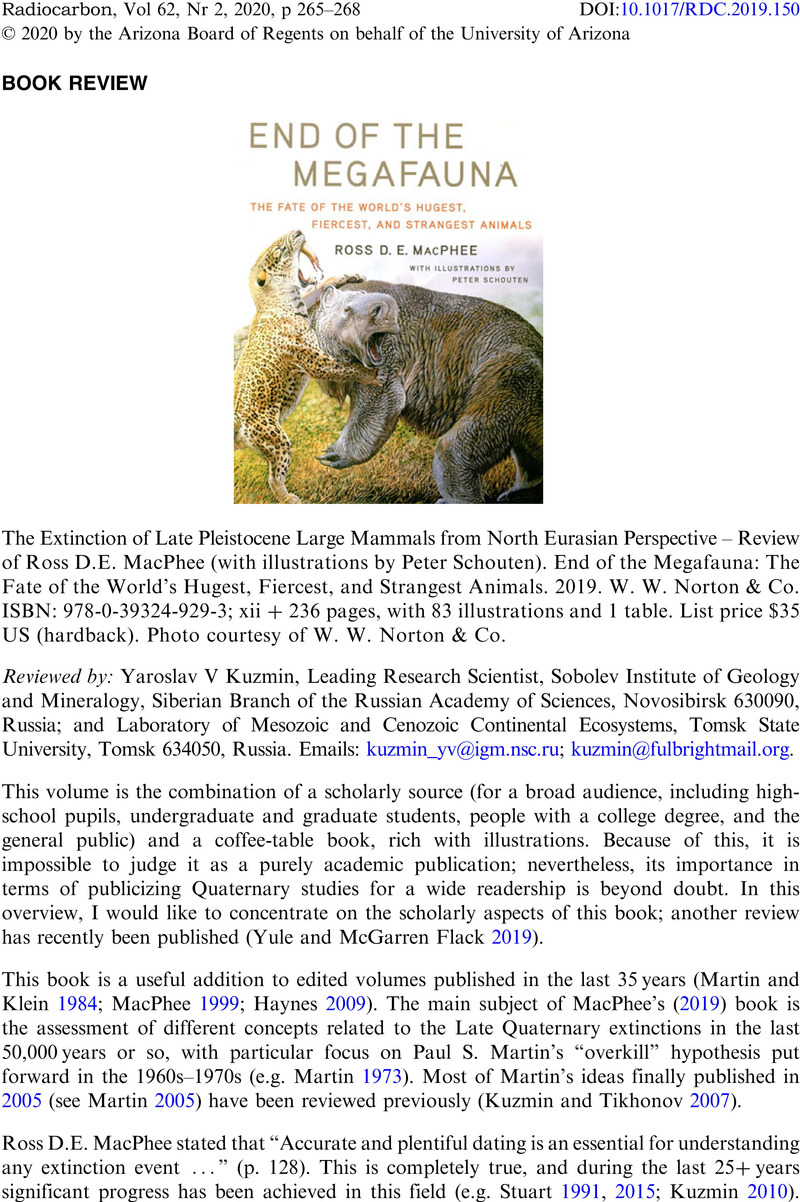No CrossRef data available.
Article contents
The Extinction of Late Pleistocene Large Mammals from North Eurasian Perspective – Review of Ross D.E. MacPhee (with illustrations by Peter Schouten). End of the Megafauna: The Fate of the World’s Hugest, Fiercest, and Strangest Animals. 2019. W. W. Norton & Co. ISBN: 978-0-39324-929-3; xii + 236 pages, with 83 illustrations and 1 table. List price $35 US (hardback). Photo courtesy of W. W. Norton & Co.
Published online by Cambridge University Press: 13 January 2020
Abstract
An abstract is not available for this content so a preview has been provided. Please use the Get access link above for information on how to access this content.

- Type
- Book Review
- Information
- Copyright
- © 2020 by the Arizona Board of Regents on behalf of the University of Arizona
References
REFERENCES
Agam, A, Barkai, R. 2018. Elephant and mammoth hunting during the Paleolithic: a review of the relevant archaeological, ethnographic and ethno-historical records. Quaternary 1:3. doi: 10.3390/quat1010003.CrossRefGoogle Scholar
Alroy, J. 2001. A multispecies overkill simulation of the end-Pleistocene megafaunal mass extinction. Science 292(5523):1893–6.CrossRefGoogle ScholarPubMed
Anderson, DG, Goodyear, AC, Kennett, J, West, A. 2011. Multiple lines of evidence for possible human population decline/settlement reorganization during the early Younger Dryas. Quaternary International 242:570–83.CrossRefGoogle Scholar
Brook, R, Bradshaw, CJA, Cooper, A, Johnson, CN, Worthy, TH, Bird, M, Gillespie, R, Roberts, RG. 2013. Lack of chronological support for stepwise prehuman extinctions of Australian megafauna. Proceedings of the National Academy of Sciences of the USA 110(36): E3368. doi: 10.1073/pnas.1309226110.Google ScholarPubMed
Broughton, JM, Wietzel, EM. 2018. Population reconstructions for humans and megafauna suggest mixed causes for North American Pleistocene extinctions. Nature Communications 9:5441. doi: 10.1038/s41467-018-07897-1.CrossRefGoogle ScholarPubMed
Fiedel, SJ. 2009. Sudden deaths: the chronology of terminal Pleistocene megafaunal extinction. In: Haynes, G, editor. American megafaunal extinctions at the end of the Pleistocene. Dordrecht: Springer. p 21–37.CrossRefGoogle Scholar
Haynes, G, editor. 2009. American megafaunal extinctions at the end of the Pleistocene. Dordrecht: Springer. 201 p.CrossRefGoogle Scholar
Kuzmin, YV. 2008. Siberia at the Last Glacial Maximum: environment and archaeology. Journal of Archaeological Research 16(2):163–221.Google Scholar
Kuzmin, YV. 2010. The extinction of woolly mammoth (Mammuthus primigenius) and woolly rhinoceros (Coelodonta antiquitatis) in Eurasia: review of chronological and environmental issues. Boreas 39(2):247–61.CrossRefGoogle Scholar
Kuzmin, YV. 2011. Mammalian fauna from Palaeolithic sites in the upper Yenisei River basin (southern Siberia): review of the current zooarchaeological evidence. International Journal of Osteoarchaeology 21(2):218–28.CrossRefGoogle Scholar
Kuzmin, YV. 2019. The older, the better? On the radiocarbon dating of Upper Palaeolithic burials in Northern Eurasia and beyond. Antiquity 93(370):1061–1071.CrossRefGoogle Scholar
Kuzmin, YV, Keates, SG. 2018. Siberia and neighboring regions in the Last Glacial Maximum: did people occupy northern Eurasia at that time? Archaeological and Anthropological Sciences 10(1):111–124.Google Scholar
Kuzmin, YV, Tikhonov, AN. 2007. The Quaternary extinctions in the Americas from a Siberian perspective: review of Paul S Martin. Twilight of the mammoths: Ice Age extinctions and the rewilding of America. Radiocarbon 49(1):183–186.Google Scholar
MacPhee, RDE, editor. 1999. Extinctions in near time: Causes, contexts, and consequences. New York: Kluwer Academic/Plenum. 394 p.CrossRefGoogle Scholar
MacPhee, RDE. 2019. End of the megafauna: The fate of the world’s hugest, fiercest, and strangest animals. New York: W. W. Norton. 236 p.Google Scholar
Martin, PS. 2005. Twilight of the mammoths: Ice Age extinctions and the rewilding of America. Berkeley & Los Angeles: University of California Press. 250 p.Google Scholar
Martin, PS, Klein, RG, editors. 1984. Quaternary extinctions: A prehistoric revolution. Tucson: University of Arizona Press. 892 p.Google Scholar
Nikolskiy, PA, Pitulko, VV. 2013. Evidence from the Yana Palaeolithic site, Arctic Siberia, yields clues to the riddle of mammoth hunting. Journal of Archaeological Science 40(12):4189–97.CrossRefGoogle Scholar
Nikolskiy, PA, Sulerzhitsky, LD, Pitulko, VV. 2011. Last straw versus Blitzkrieg overkill: climate-driven changes in the Arctic Siberia mammoth population and the Late Pleistocene extinction problem. Quaternary Science Reviews 30(17–18):2309–2328.CrossRefGoogle Scholar
O’Connell, JF, Allen, J, Williams, MAJ, Williams, AN, Turney, CSM, Spooner, NA, Kamminga, J, Brown, G, Cooper, A. 2018. When did Homo sapiens first reach Southeast Asia and Sahul? Proceedings of the National Academy of Sciences of the USA 115(34):8482–8490.CrossRefGoogle ScholarPubMed
Pitul’ko, VV, Pavlova, EY. 2016. Geoarchaeology & radiocarbon chronology of Stone Age Northeast Asia. College Station, TX: Texas A&M University Press. 222 p.Google Scholar
Pitulko, VV, Tikhonov, AN, Pavlova, EY, Nikolskiy, PA, Kuper, KE, Polozov, RN. 2016. Early human presence in the Arctic: evidence from 45,000-year-old mammoth remains. Science 351(6270):260–263.CrossRefGoogle ScholarPubMed
Saxon, EC. 1979. Natural prehistory: The geology of Fuego-Patagonian ecology. Quaternaria 21:329–356.Google Scholar
Sinitsyn, AA, Stepanova, KN, Petrova, EA. 2019. New direct evidence of mammoth hunting from Kostenki. Prehistoric Archaeology 1(1):148–159. In Russian with English abstract.Google Scholar
Stuart, AJ. 1991. Mammalian extinction in the Late Pleistocene of Northern Eurasia and North America. Biological Review of Cambridge Philosophical Society 66(4):453–562.CrossRefGoogle Scholar
Stuart, AJ. 2015. Late Quaternary megafaunal extinctions on the continents: a short review. Geological Journal 50(3):338–363.CrossRefGoogle Scholar
Taylor, RE, Bar-Yosef, O. 2014. Radiocarbon dating: An archaeological perspective. 2nd ed. Walnut Creek, CA: Left Coast Press. 403 p.Google Scholar
Westaway, KE, Louys, J, Due Awe, R, Morwood, MJ, Price, GJ, Zhao, J-X, Aubert, M, Joannes-Boyau, R, Smith, TM, Skinner, MM, Compton, T, Bailey, RM, van den Bergh, GD, de Vos, J, Pike, AWG, Stringer, C, Saptomo, EW, Rizal, Y, Zaim, J, Santoso, WD, Trihascaryo, A, Kinsley, L, Sulistyanto, B. 2017. An early modern human presence in Sumatra 73,000–63,000 years ago. Nature 548(7667):322–325.Google ScholarPubMed
Wroe, S, Field, JH, Archer, M, Grayson, DK, Price, GJ, Louys, J, Faith, JT, Webb, GE, Davidson, I, Mooney, SD. 2013. Climate change frames debate over the extinction of megafauna in Sahul (Pleistocene Australia-New Guinea). Proceedings of the National Academy of Sciences of the USA 110(22): 8777–8781.CrossRefGoogle Scholar
Yule, JV, McGarren Flack, D. 2019. Review [MacPhee R.D.E. End of the Megafauna: The fate of the world’s hugest, fiercest, and strangest animals]. Quarterly Review of Biology 94(2):228–229.Google Scholar
Zenin, VN, Leshchinsky, SV, Zolotarev, KV, Grootes, PM, Nadeau, MJ. 2006. Geoarchaeology and peculiarities of material culture of the Lugovskoe Paleolithic locality. Archaeology, Ethnology & Anthropology of Eurasia 7(1):41–53.CrossRefGoogle Scholar




